Apr 20, 2024
Apr 20, 2024
Shore Temple
During the x-mass holidays 2013, I had just 7 days for a tour.
Since I had not planned in advance, I was thinking where to go. My better half Jana suggested, why not Mamallapuram. I had been there with my parents when I was only 11, and I had only faint memories. Yes, memories need to be polished; and the change (or evolution) in the Eye needs to be cherished.
Mahabalipuram, also known as Mamallapuram is a town in Kancheepuram district in Tamil Nadu.
The earlier visit to Mamallapuram was a one day tourist trip from Chennai. Nowadays I reject such one-day hectic tour because it is not enough to know a place. Such tourist trip is merely touching the surface, and most is left unexplored.
Mamallapuram is indeed an all-in-one. Other than being a historic place, it is also renowned as a sculpture town. The Bay of Bengal is soothing blue, and more importantly, the beech here is not congested.
History, geography, arts, serenity, beauty and peace - quite a package that very few places can boast of…
For me, the most desirable bonus is the association with Mahabharata, as some of the sculptures depict Mahabharata characters and events.
So, we decided to go there and there only. We decided, this time we would stay for four days in Mamallapuram. The added attraction this time would be the ongoing Beach Festival.
On 27th December we reached Chennai Egmore by train from Howrah, spent the night there, and next day we booked a cab taxi for Mamallapuram.
The cab taxi service is an excellent gift of the Tamilnadu government to tourists.
We reached the 60 km distance to Mamallapuram within 2 hours. It is an excellent journey along a coastal road.
Myth and History
Mahabalipuram was the earlier name of Mamallapuram because the demon king Mahabali was killed by Lord Vishnu at this place.
The name was changed later by the king of Pallava Narashima Varman (630–668 CE) who has got the title of Mamalla; the great wrestler. He avenged his father's defeat at the hands of the Chalukya king, Pulakeshin II in the year 642 CE. He shared his father Mahendravarman I's love of art and completed the work started by Mahendravarman in Mahabalipuram.
It was during his reign, in 640 AD, that the Chinese traveler Hieun Tsang visited Kanchipuram.
Mahabalipuram became a well established sea port during the 7th and 10th centuries of the Pallava dynasty. This was the second capital of the Pallavas who ruled Kanchipuram.
The Shore Temple
We reached Mamallapuram at 10 am. Settling my wife and daughter at an ATM booth, I set out for a suitable accommodation-hunt.
I started from the junction of E Raja Street and Othavadai Street, and walked along the Othavadai Street towards the beech. Hotels are aplenty on either side of the street. I wanted a place that would be on the beech, or very near to the beech, and at the same time the Shore-temple would be 5-10 minutes walking distance.
Finally, I got a favourable one.
My daughter Anisha (8 years), now impatient to go to the beech hardly allowed us any rest. So, we set out within 1 hour of checking in.
First, we went to the famous Shore Temple.
The Shore Temple was built in 700–728 AD. The structural temple is built with blocks of granite, on a promontory sticking out into the Bay of Bengal. As one of the Group of Monuments at Mahabalipuram, it has been classified as a UNESCO World Heritage Site since 1984. It is one of the oldest structural (versus rock-cut) stone temples of South India.
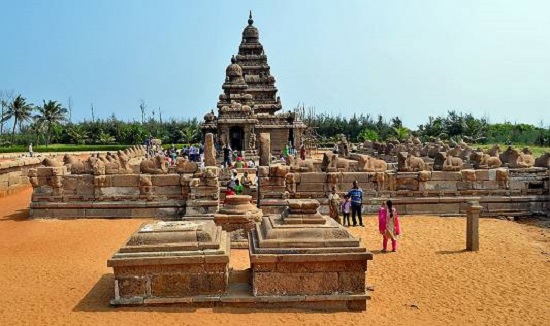
Shore Temple
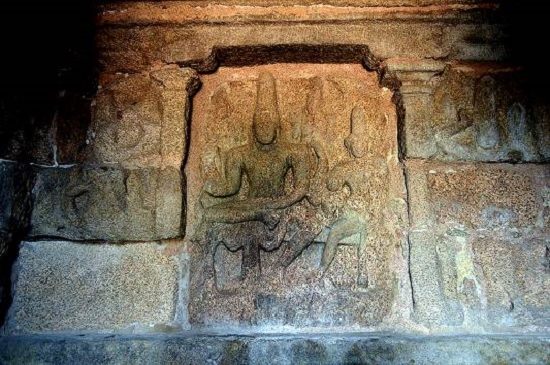
Decaying sculptures on Shore Temple
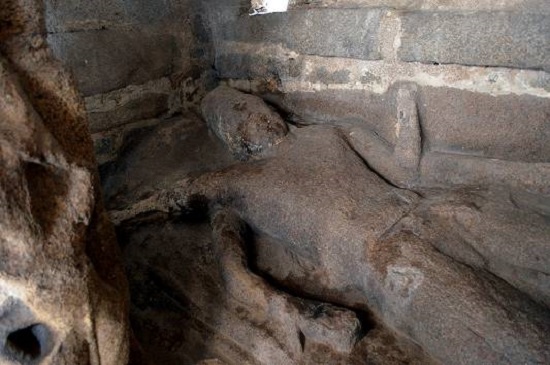
Vishnu on Anantashajya
The Pancha Rathas
The famous Pancha Rathas (also known as Pandava Rathas) (late 7th century) is an example of monolithic Indian rock-cut architecture.
Each of the five monuments in the Pancha Rathas complex resembles a chariot (ratha), and each is carved over a single, long stone or monolith, of granite which slopes in north-south direction with a slight incline. The monuments, sometimes mistakenly referred to as temples, were left incomplete following the death of Narasimhavarman I.
Though the structures are named after the Pancha Pandavas and their common wife Draupadi, in reality they have nothing to do with Mahabharata. Yet, the fact that these monuments are now popularly known as Pandava Rathas, only show the power of Mahabharata in her sweep over Indian Civilization and Culture.
Entering the gate, one would notice a line of temples on the left, a giant lion and elephant in the middle, and another temple on the right of them.
The first Ratha on the left is Draupadi-Ratha. Next to it is the Arjuna-Ratha. Behind the Arjuna-ratha is a huge rock-bull. Next to Arjuna-ratha is Bhima-ratha, and after that the Dharmaraja-ratha. The Nakula-Sahadeva-ratha stands single opposite to the Arjuna and Bhima-ratha with the rock-elephant in between.
The plaque displayed at the site by the ASI says that the Pallava dynasty had planned the structures as models of chariots in rock based on prototypes of ancient rathas built in wood; the purpose however, remains unknown.
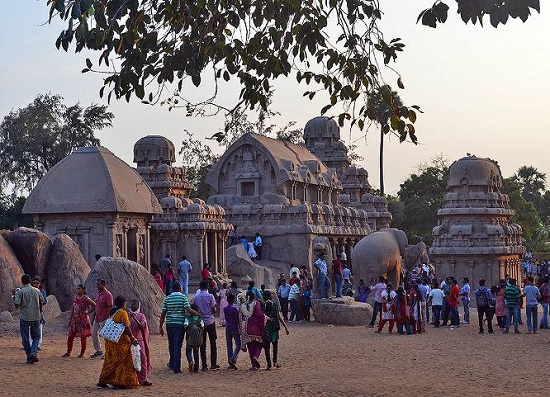
The Pancha Rathas – viewed from the Gate
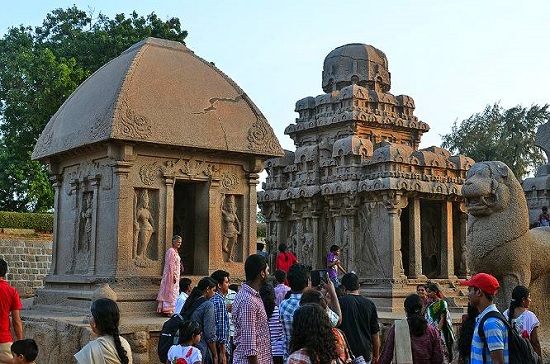
Draupadi Ratha (left) and Arjuna Ratha (right)
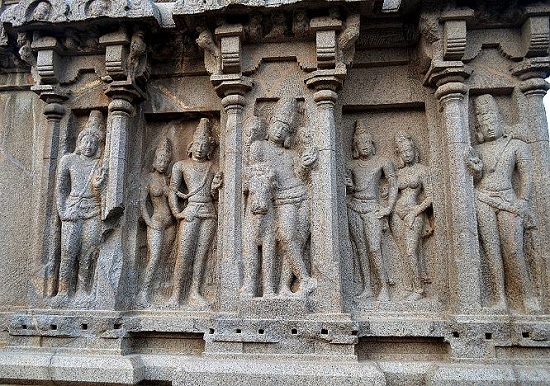
Sculptures on the Arjuna Ratha
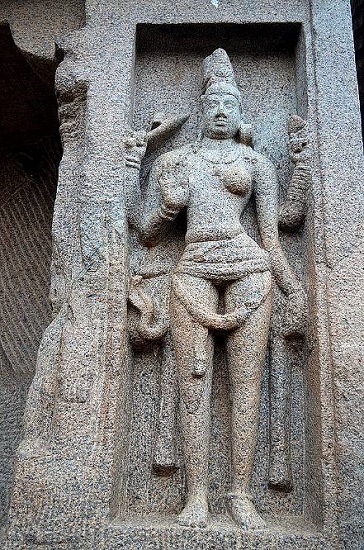
Ardhanarishvara Shiva on the Yudhishthira Ratha
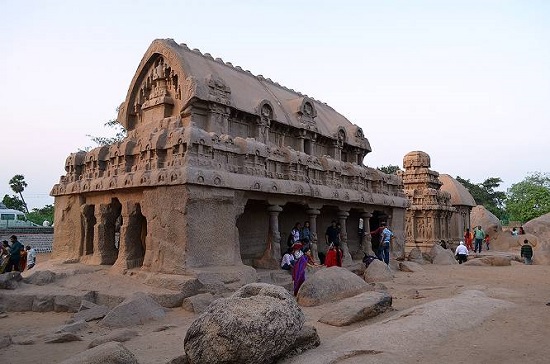
Bhima Ratha
Revision visit, new places, strolling around the Town & Beach Festival
We wake up early morning before sunrise, go to the beach to see sunrise.
The morning ambience is unique.
We find fishermen readying for their morning chores. However, what catches the eye is that of foreign guests performing Yoga on the beach.
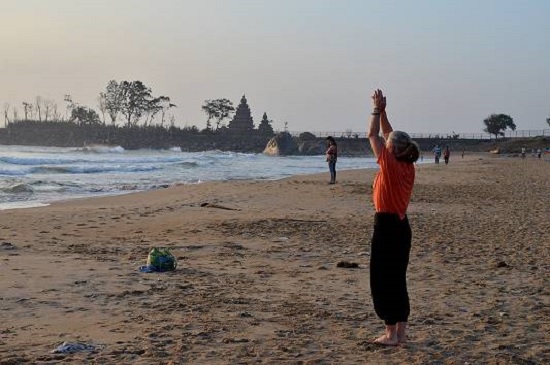
Yoga on the beach – at the backdrop is the Shore Temple
Today, I do a revision visit for some detail study and information as also for taking better photos.
Strolling around the town is a real pleasure. It is a sculpture town, and on either side of the roads one would find display of sculptures and paintings.
The artistic taste of the town appeals aesthetically, and tunes the mind to an elevated level.
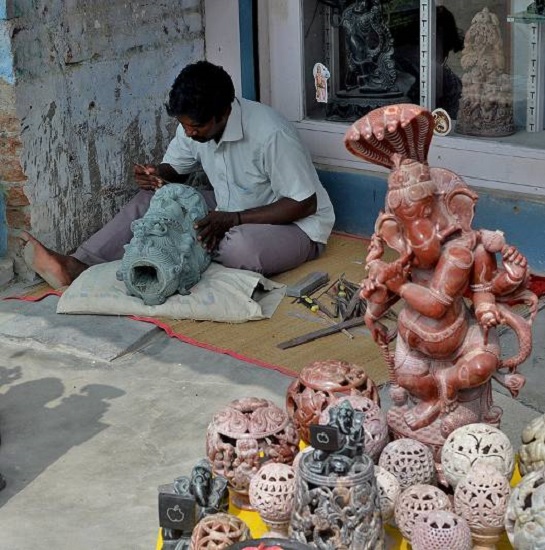
Sculptor in action
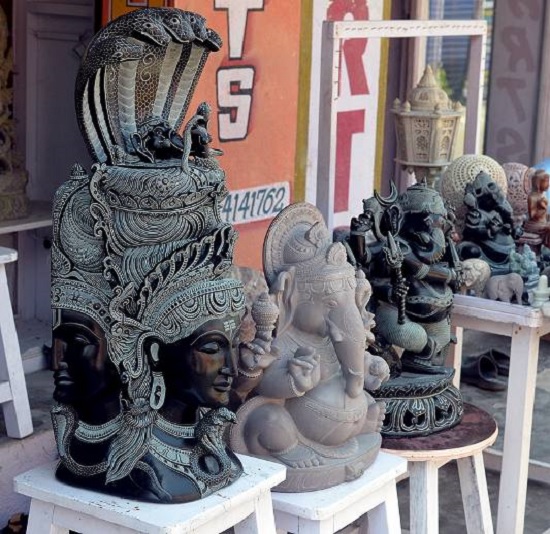
Sculpture displays
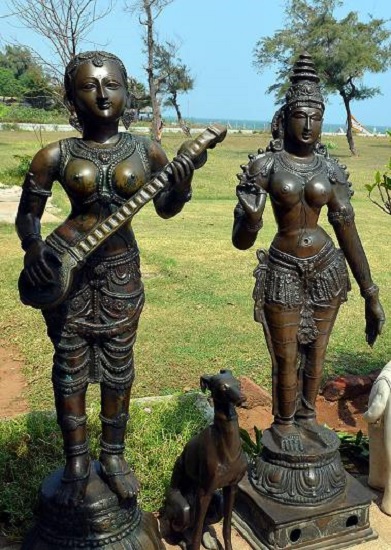
Metal work displays
We spend the evening on the beach. Nothing is more pleasing than watching my daughter playing with the waves in her knee-deep water.
Then we buy fish fries and chips, and go and watch the Beach Festival.
The performances of the danseuses leave us spell-bound. Aesthetics upon aesthetics … the mind soars high …
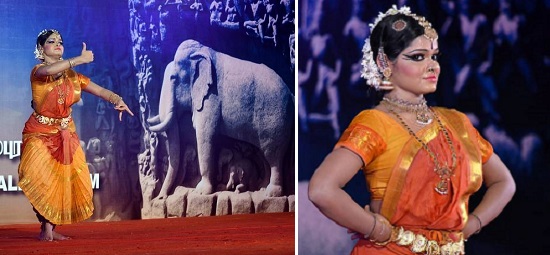
Beach Festival
16-Oct-2016
More by : Indrajit Bandyopadhyay